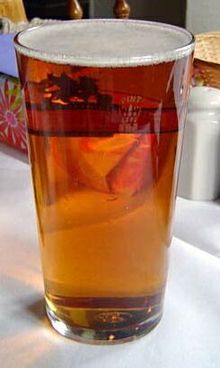Pint glass
[citation needed] Older styles include: In the United Kingdom, draught beer must be sold in Imperial measure (see Pint § Effects of metrication).
[citation needed] Under the EU Measuring Instruments Directive (Directive 2004/22/EC), the certification of measuring instruments and devices used in trade (including beer mugs, weighbridges, petrol pumps and the like) can be done by third parties anywhere within the EU with governments taking "only the legislative and enforcement (market surveillance) functions" and "ensuring that the system of third party assessment ... has sufficient technical competence and independence"[7] (or, in simple language, calibration services were privatised).
[12][13] The Campaign for Real Ale (CAMRA) has described this practice as selling a short measure, and says that it costs drinkers £1 million a day in beer they have paid for but not received.
The British Beer and Pub Association has issued guidelines for bar staff to give a "top up" to any drinker who is unsatisfied with the measure they receive.
As in the UK, certified glassware must be used; the capacity of the beer glass is defined by either the brim or, where present, the fill line.
[citation needed] In Israel, although officially defined as 568ml,[19] pubs use the term arbitrarily and the "pints" served constitute a wide range of volumes (360ml–440ml).
[20] In order to avoid raising prices at pubs, and as a result, the loss of customers, a new standard beer measurement appeared; the "pint".
With a half-inch of foam, the actual liquid fill is roughly 14 US fl oz (410 ml), missing one eighth of its volume.
The markings themselves are formed from small pits, which aid in nucleation, allowing the gas within it to be released more easily, thus preserving the head.
[26] The markings come in a variety of styles ranging from a simple circular or square hatched pattern to more complicated branding messages.
[citation needed] Pint glass collecting is a way for individuals to commemorate their visits to popular tourist destinations, most notably to microbreweries or sports arenas.






